ONTARIO SCIENCE CENTRE – OCTOBER 7, 2016
On Friday, October 7, 2016, the Giant Screen Cinema Association’s (GSCA) Technical Committee hosted a digital dome demo in the Shopper’s Drug Mart Omnimax Theatre at the Ontario Science Centre in Toronto, Ontario. During this historic demo, the audience witnessed something that no other audience had ever seen before.
INTRODUCTIONS
To show the latest digital technology to GSCA members, the Technical Committee co-chaired by Martin Howe and Tim Hazlehurst, sent out an open request for proposals for 8K digital dome systems, and Evans & Sutherland responded with a comprehensive plan to demonstrate everything specified and requested. As Martin explained, “E&S was therefore awarded this opportunity to demonstrate their digital solution to replace 15/70 film in giant screen domes. As E&S and the Technical Committee developed the program for the presentation, E&S upped the ante and instead of demonstrating an “8K” system (which produces 6500 x 6500 unique pixels and E&S demonstrated twice before for the GSCA), they decided to install a True8K system using 10 Christie Mirage 304K projectors, that before this demo, had never been demonstrated in a giant screen dome, anywhere in the world. This system represents the state-of-the-art of digital dome systems.”
Martin then introduced Gordon Stalans, GSCA Chair, who welcomed the audience, thanked Ontario Science Centre, FotoKem, E&S, and Christie for all their hard work that made the demo possible. Gordon also let the audience know that great care was taken to provide excellent 8K sources for the audience to be able to most effectively evaluate the True8K digital solution: new film prints were made and digital 8K scans were mastered in 8K resolution. Additionally, a variety of new footage was shot in 8K for the event and a variety of other 8K material was generously provided for the demo. Gordon shared GSCA’s vision for educating members and helping them navigate through the world of digital technology.
INITIAL DEMOS
To begin the demos, Martin introduced some of the 8K footage E&S presented last fall during Dome Day at the Tech Museum in San Jose. First, was the trailer for Alaska – Spirit of the Wild scanned by FotoKem in 8K (but with no digital mastering); next, the trailer for Space Next, natively rendered in 8K CGI; finally, a short montage of 8K content collected and mastered by E&S. Note that last fall, E&S installed a five projector “8K” system with approximately 6500 x 6500 unique pixel resolution. The system installed in Toronto used 10 projectors to create a True8K image with at least 8000 x 8000 unique pixel resolution.
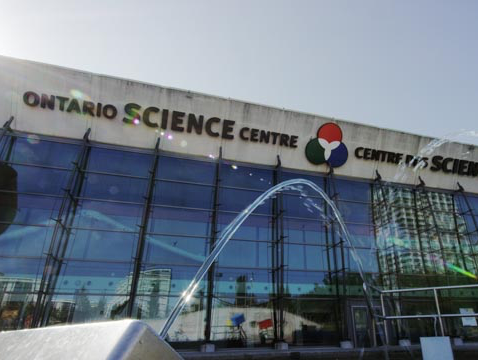
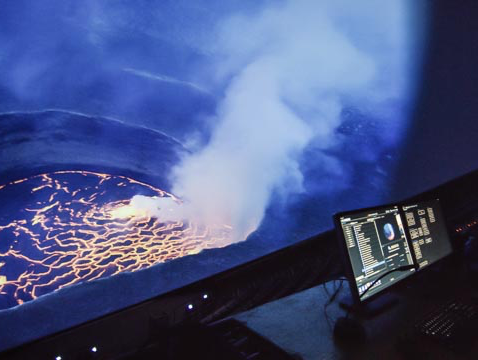
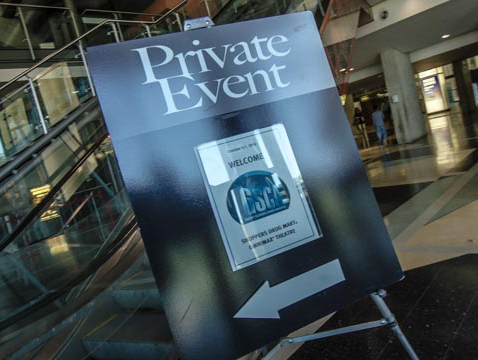
THE SYSTEM
Martin handed things over to Michael Daut, GSCA Board Member and Creative Director/Marketing Director for E&S. Michael began, “As Martin said, today we are experiencing history in the making. In the GSCA board meetings during the conference, we’ve spent a lot of time talking about relevance. Being relevant to the industry. I think today’s demo is a perfect example of something that is of great interest to all of us who have giant screen domes and for those of us who produce films for the dome. This is the first time a True8K system has been installed and demonstrated in a giant screen dome (24 meters), and this is a system that is commercially available and can be installed today. It’s a lot more affordable than you might imagine.”
The temporary installation featured a few projectors in places they would not normally be installed. There were four projectors inside the theater in front of the first row of seats. In an actual installation, they would have been placed behind the dome screen and about 45° on either side of the center, making them virtually invisible to the audience.
In 2014, E&S went head-to-head with 15/70 film at the Science Museum of Virginia in the GSCA’s first Digital Dome Demo. E&S presented an “8K” system there as well (6500 x 6500 pixels) with 5 Christie D4K25 projectors, the predecessor to the Christie Mirage 304K. Then in 2015, E&S presented another “8K” digital dome demo at the GSCA Dome Day at The Tech Museum in San Jose, CA, this time using Christie Boxer 4K30 projectors.
At this year’s demo, in partnership with Christie Digital, E&S presented a system with twice as many projectors as in Richmond or San Jose, with at least twice the on-screen resolution.
THE SPECIFICATIONS
This is the temporary system E&S and Christie installed:
- 10 Christie Mirage 304K projectors – lamp based (system could be done with RGB laser or laser phosphor projectors. The latter are installed in a True8K system in Houston, TX)
- True8K resolution – minimum of 8000 x 8000 across every meridian (or arc through the zenith)
- 40 Dell Graphics Processor computers (GPs) for stereo 3D and 120 Hz playback (20 GPs needed for 2D and/or 60 Hz)
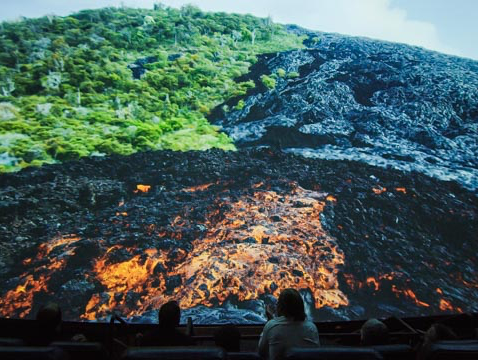
- Digistar system with ultra-high resolution playback and real time graphics using TrueSync technology
- E&S’ proprietary auto alignment and auto blend to create unified image
- XpanD 3D system with IR emitters and active stereo glasses at 120 Hz
- 5.1 audio
- Video encoded at 50 MBps per GP
What the system achieved:
- Just under 4 fL (since the projectors up front would normally be behind the dome, lenses with wider fields of view were used to accommodate these positions inside the dome). This means that the overall brightness was tuned down to match the levels of these projectors.
- 2000:1 contrast
- At least 8000 x 8000 pixels across every meridian (semicircle arc through the zenith of the dome)
- Digistar system plays digital audio as slave to IMAX projector
- Sync between IMAX projector and Digistar
- DIGSS compliant system
What E&S has installed to date:
- Five GS theaters converted from 1570 to digital by E&S – 1 4K and 4 8K: Latest – Milwaukee Public Museum 8K- Opened last month
- World’s first True8K theater opened this spring in Houston, TX (50′ dome with 10 Sony laser phosphor projectors)
- systems have been performing beautifully since installation
15/70 FILM VS. DIGITAL TRUE8K
Phil Streather, GSCA Board Member, filmmaker, and CEO of Principal Large Format, stepped up to introduce the 15/70 and Digital 8K demonstration. Phil began, “One of the key reasons for today’s demo is to show our members digital replacement options for 15/70 film, since film is quickly disappearing as an exhibition medium, particularly in the 3D flat screens; although film is still being used as an acquisition format and should seriously be considered as an archival format. Most giant screen films are being finished digitally in the computer through the DI process (Digital Intermediate). Some producer/distributors, like SK Films, go the extra mile and produce a dome specific negative from these digital assets but, going forward there is uncertainty about how long there will be film in domes and so some producers are holding off making dome prints altogether. Phil continued, “Having a digital dome solution that matches or exceeds the quality of 15/70 film would surely hasten the take up of digital in domes and thus potentially expand the number of new films that are available for giant screen domes, if those films could remain in digital format.”
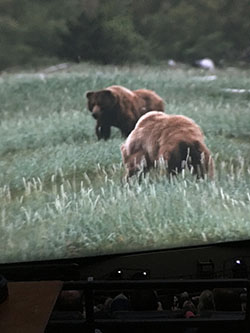
Phil said, “Today, we’re going to see how 8K digital, specifically True8K, performs against 15/70 film. Once again we would like to thank Evans & Sutherland for their hard work and courage to present a demo that until today, no one has seen before. We have footage from two Giant Screen films; Alaska and Jerusalem. So, huge thanks to Graphic Films/K2 Communications for Alaska and Cosmic Picture/National Geographic for Jerusalem. And thanks to FotoKem for all their printing and DI work. I would like to introduce Andrew Oran, of FotoKem, who oversaw the creation of the demo materials for this test, to tell us about the process used in mastering these digital and film assets that we’re going to see this morning.”
Andrew stepped to the microphone. “The two titles underwent different post-production pipelines on their road to the dome here today,” he said. “For Alaska – a show shot completely on film, and almost entirely on 15p, we used an archive of 8K scans from the show’s 15p interpositive, For Jerusalem, a show shot with both film and digital cameras, we used an archive of 8K scans from 15p original negative for two shots – a Spacecam aerial and a MSM9802 ground shot, both of which were filmed on Kodak 250D film stock – as well as original, raw data files from the Sony F65 and Red Epic cameras. The Sony F65 raw files were debayered and transcoded to full 8K x 4K resolution through the Sony SRDM, or Super Resolution De-Mosaicing processor. The resulting files, with an aspect ratio of 1.9:1, were cropped to 4:3 in DI: a process that involved taking a 4K high by 5.5K wide 4:3 center extraction from the F65 source and uprez’ing that extraction to a full 8K wide by 6K high file. The one 5K Red Epic shot in this reel was cropped and then uprez’d to the same 8K resolution, though in that instance from a 3,600 x 2,700 pixel 4:3 center extraction area.”
Andrew summarized, “In other words, and in general, we re-created the DI for the Jerusalem reel from scratch, but at 8K. All of the 65mm 8K scans, by the way, were done at IMAX Corp, for previous scopes of work.”
He continued, “Our focus in DI was on color, brightness and contrast. We limited our digital clean-up, due mainly to time constraints, so some imperfections remain in the digital version of the film-sourced material. We deflickered several shots to achieve a more uniform look to each reel. Our starting point for color correction was approximating the look of a reference ProRes QT derived from a 70mm telecine transfer of the 1570 prints we’ll be projecting for you today, but we soon decided to use the digital mastering tools to their maximum potential, to present the best version of each reel based on each of the mastering and exhibition technologies. The photo-chemical pipeline is represented by a print from original negative; and the digital pipeline from raw data and best available scans that have gone through a full 8K color grade, contrast tweak, deflicker process, etc. That having been said, the available Alaska scans, made from the show’s 15p IP, would, theoretically, yield resolution slightly under what we might expect from scans of the show’s 15p original negative.”
In closing, Andrew mentioned, “The digital versions of each reel were delivered to E&S as uncompressed 8K x 6K DPX files (each file just over 200 MB, with a pixel count of 8192 x 6144, for the accountants in the audience) where they were warped for dome display, and encoded as a set of H.264 videos for playback on 20 GPU’s. All told, 3.8 TB of data were delivered to E&S for the full 11 minutes of 8K content.”
Phil summarized the technical background, “We will show you the unsharpened digital frames against the sharpened frames in the 8K Digital Mastering Section that follows, but first, we are going to look at the quality of 1570 film vs. True8K digital. Let’s start with film. The elements we are going to watch were cut in the same sequence in the 1570 edit and the digital 8K edit, so you will see the exact same content in both formats for the most accurate comparison of quality.”
1570 FILM PRESENTATION
To stress the quality of the elements, Andrew Oran stated, “These are new 1570 prints from original negative. In the case of Alaska, the show had only been printed at FotoKem before from duplicate negative, so we struck a new dupe neg print and then matched, through a manual, photo-chemical color timing process, the original negative print to the approved duplicate negative print.”
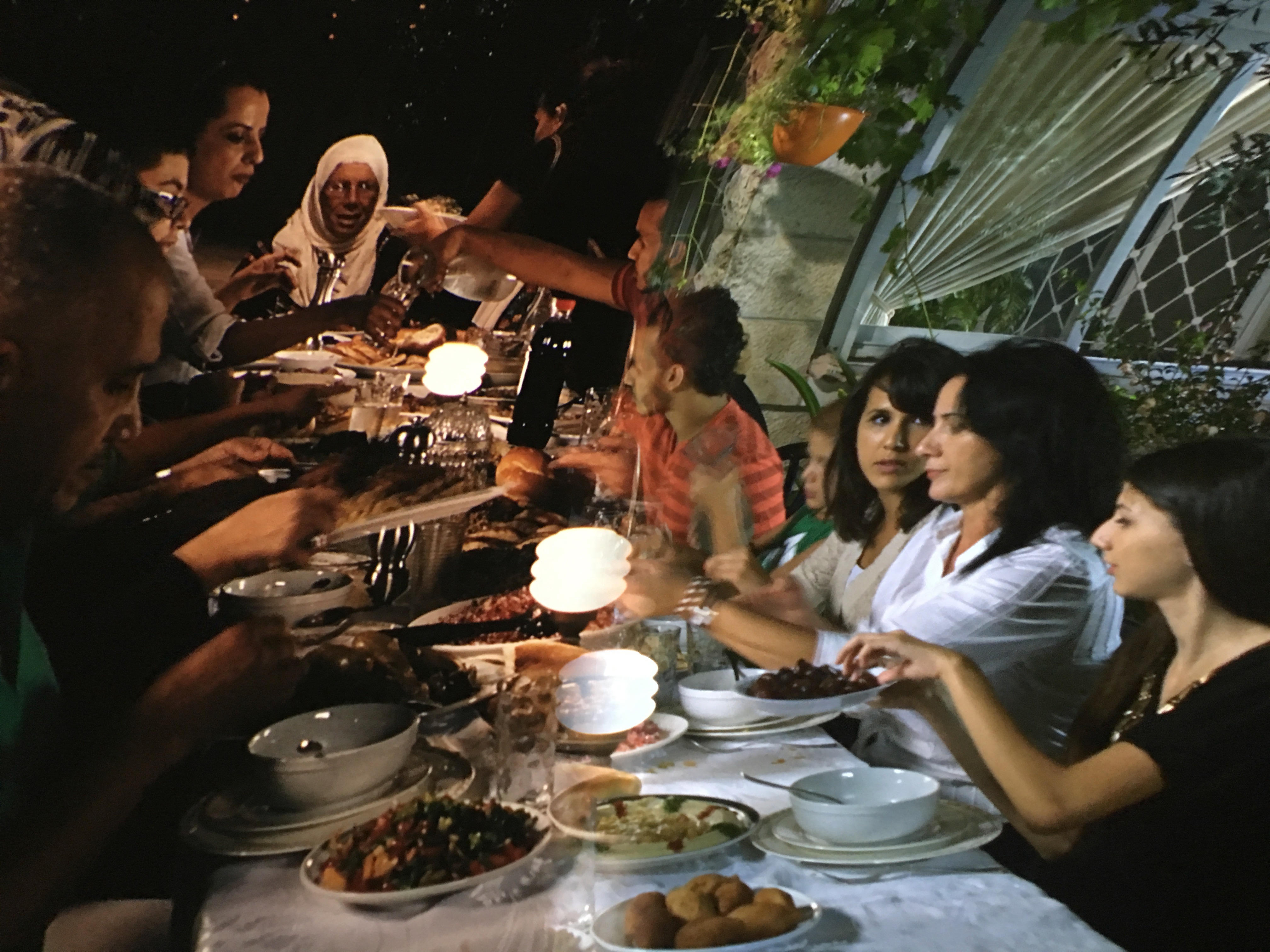
“In the case of Jerusalem, we’re looking at new 1570 print from the LEFT eye original negative assembly, printed at the show’s 2D color timing. FotoKem assembled the two 1570 reels, along with projection chart and leaders, to frame-accurately match the conform of the digital edit… to – hopefully – insure that we don’t drift too far out of sync when we split-screen the two projection technologies,” he said.
“The running order is a 15/70 projection chart, one that’s often referred to as the ‘sacred master,’ followed by reel 4 of Alaska, and reel 12 of Jerusalem. The “sacred master” is there to demonstrate projection steadiness and screen coverage, and to show that the warping process for the digital version gives you similar screen coverage as that of the film version,” Andrew said.
Andrew wrapped by saying, “Thanks again to Graphic Films and K2 Communications for making Alaska available to us, and for Cosmic Picture and National Geographic for providing us the rights and access to show you Jerusalem. Thanks also to the team at FotoKem for their mastering work.”
The 15/70 film played, with Digistar’s audio locked to the film for soundtrack playback in sync with the picture.
8K DIGITAL PROJECTION
Then it was time to play the 8K digital version of the content the audience just watched in 15/70 film. Andrew Oran reminded the delegates, “The digital content, once again, was derived from IP scans for the Alaska footage, and a variety of original sources for the Jerusalem footage. The resulting 8K files were color corrected at FotoKem in a DI mastering session, and, after warping and encoding at E&S, presented here on their True8K Digistar system.
The digital version of the imagery played (measuring 4 fL against ~3 fL from the 15/70 film).
SIDE-BY-SIDE PROJECTION
Next, through a bit of technical finesse, the 15/70 film system and the Digistar system were locked together. The E&S team installed a mask that vertically split the imagery from the 15/70 projector, so that it only showed on the left side of the dome, and at the same time blanked several of the digital projectors and masked two others to split the imagery vertically, making the digital 8K imagery appear only on the right side of the screen. This gave the audience the ability to directly compare the resolution and image quality of 15/70 film mastered from pristine sources and 8K digital imagery also processed from pristine film scans or original camera files then mastered, de-flickered, and color-timed in 8K resolution. See video sample below (shot with an iPhone – complete with auto focus errors and exaggerated flicker effect on the film image that was not apparent during the event).
The side-by-side demo played again and Phil and Andrew talked over the imagery to point out a few features in both.
8K DIGITAL MASTERING SECTION
Christian Fry, filmmaker and President of Pretend Entertainment, introduced a section of digital content shot and mastered in a pure 8K digital workflow. In its purest form, this was an illustration of the importance of the work the Technical Committee did to develop the Production and Post Production Workflow (P3W) document for the GSCA. The P3W was designed to guide filmmakers through the process of shooting and mastering content in a purely digital or mixed media workflow. All footage presented in this section of the demo remained at 8K throughout digital mastering process. First, Christian introduced Michael Dalton-Smith, filmmaker and President of Digital Crossing Films, to present some groundbreaking 8K footage.
Michael described the 8K shooting process and 8K mastering process for the footage he shot specifically for the demo. Michael explained, “I used the new RED Weapon camera with the Helium 8K sensor for these tests. Some shots are full 8192 x 4320; some were cropped from that to 5760 x 4320 (4×3) and then upscaled to 8192 x 6144. Also, I did some shots shooting the bottom half of a shot and tilted up to shoot the top half and stitched those together, which resulted in pretty much True8K! I delivered TIF files to E&S for warping and display on dome.”
These shots were followed by a sequence of shots from Michael’s Volcanoes film currently in production.
JERUSALEM FOOTAGE WITH 8K POST WORKFLOW
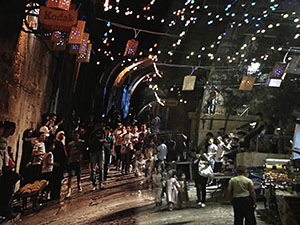
Christian Fry returned to illuminate part of the 8K digital workflow the team used at FotoKem to create the footage for the side-by-side demo. Specifically focusing on shots from Jerusalem, Christian pointed out that, “We will look at shots from Jerusalem again, this time though the perspective of a pure 8K workflow. The Sony F65 original camera files were de-Bayered through Sony’s SRDM (Super Resolution De-Mosaicing Processor) box for 8K x 4K files, then cropped for 4:3 and upscaled to 8K x 6K. Color correction was done with Mistika in 8K, and then we did a sharpening pass to enhance the imagery further.
A Mistika 8K workflow allows this level of care in the image processing while maintaining and never degrading image resolution for delivery to True8K system. A footnote to this demo, the effort we’re showing would have been completely wasted in a workflow that films out to 15/70, since today’s best film recorders are only capable of about 5K resolution. This demonstrates the power and flexibility of a purely digital 8K mastering process. We saw these clips earlier, but now we are going to show the unsharpened shots against the sharpened shots, so you can see how sharpening coaxes even more detail out of the digital 8K shots.” Christian then introduced filmmaker and President of Golden Gate 3D, Peter Chang.
Peter presented a variety of footage shot with DSLR cameras including the new 12K Phase One XF100 camera. Peter then described the shooting process and 8K mastering process with the RED Weapon with the 8K Vista Vision sensor and the RED Weapon camera with the 8K Helium sensor. Peter explained, “Some shots are RED native 8192 x 4320 with black at the top and some are cropped from that native pixel count to 5760 x 4320 (4×3) and then upscaled back up to 8192 x 6144 for the dome aspect ratio of 4 x 3. TIF files delivered to E&S for warping and display on dome.”
After this collection of amazing imagery from Cuba played, the audience was invited to take a 20-minute break.
BRING BACK OUR WIDE SHOTS DEMO
After returning to the theater, audience members were handed XpanD 3D glasses for an upcoming fulldome stereo 3D demo in the second session, but before the 3D examples, there was a lot more great content to show.
Phil Streather, of Principal Large Format, took the stage to present an 8K version of the GSCA’s digital camera test material, affectionately called, Bring Back Our Wide Shots (BBOWS) inspired by the hope that digital video cameras would be able to capture shots with enough quality to match the resolution of 65 mm film when put through a digital pipeline. Phil elaborated, “We’re going to see the original 4K BBOWS version 2.0, with all the image sharpening of the digital footage and the deflickering of the film footage, so both are the best they can be. This has been upscaled to 8K, preserving the original aspect ratios in a 4:3 container. The idea is for you to be able to see what 4K upscaled looks like; does it hold up at all or prove that for successful 8K projection you need 8K acquisition?”
DIGITAL TIME LAPSE SHOTS
Michael Daut introduced several time lapse sequences shot with DSLR still cameras. He said, “A high resolution DSLR is the most affordable way to create beautiful high resolution imagery on the dome. We have an excellent sampling of imagery to show. The first example was shot with a Canon 5D Mark III camera with a Canon 8 mm fisheye lens. Our team at E&S captured this time lapse footage at 6K x 6K resolution in fisheye format and upscaled to 8K x 8K to fill the entire dome screen. It’s incredibly immersive.”
Michael continued, “The next example is brand new footage shot by filmmaker Steven McNicholas just for this demo. This is 6666 x 4992 time lapse material upscaled to 8K and then warped for the digital dome. We did image processing and color correction in 8K on the Mistika system at FotoKem.”
“Our final time lapse material was shot by filmmaker Lincoln Athas just for our demo today. This is DSLR footage shot at 6666 x 4992 upscaled to 8K and then digitally warped. Lincoln did all image processing and color grading.”
HIGH FRAME RATE (HFR) DEMO
Pierre Routhier introduced a selection of high frame rate shots that he captured for the demo. He shot this footage at 120 frames per second, the first time footage at this frame rate has ever been presented in a digital dome.
Pierre described his goal for this test, “I wanted to get a “subjective” impression of what fluid motion looks like in a dome environment: Does it look more immersive, or does it feel like watching HD video? Of course there were some challenges in capturing high quality dome images at ultra-high frame rates including:
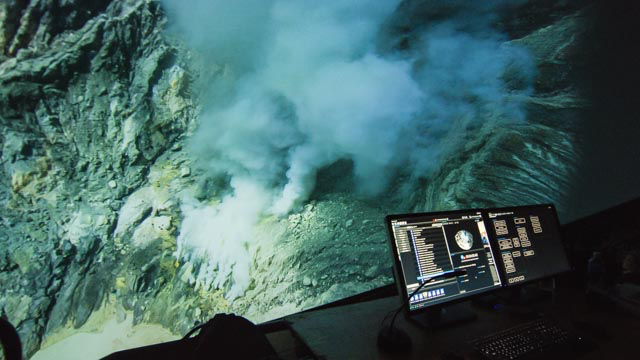
- Heavy compression ratios
- Partial sensor coverage
- Lower available light due to high shutter speed
- Nighttime time-lapse exposure times are too long to capture HFR in the traditional way.”
He continued, “What is in the demo?
- Pan and tilt shots (relatively slow for dome viewing comfort)
- Static shots with significant motion within the image (waves, waterfalls, etc…)
- Composite time-lapse (different native frame rates for sky and sea within a single shot)
- Interpolated time (lower frame-rate capture interpolated to HFR with motion algorithms)”
FULLDOME STEREO 3D
Michael next introduced the fulldome stereo 3D clips using active shutter glasses and IR emitters provided by XpanD. He said, “Now we’re going to see two stereo 3D clips produced in the native fulldome digital format. The imagery will cover the entire dome. It was also produced natively in 8K 3D and played back from 40 PCs into the ten projectors each with 2 inputs for Left eye and 2 inputs for Right eye (4 inputs per projector), all playing together precisely with our TrueSync technology.” He presented a trailer from the upcoming Mars 1001 fulldome film produced by Mirage3D and E&S, then a segment of the film We Are Stars produced by National Space Centre in the UK.
ALTERNATIVE CONTENT
Michael then introduced the final section of the demo that featured alternative content that can be presented in a digital dome theater. He began, “As we know, there has been a lot of discussion about different kinds of content that can be presented on a digital system, since it inherently has more flexibility and versatility than a film-based system. One of the incredible strengths of Digistar is its ability to present real-time content on a variety of topics. The system essentially has been designed around a complete real-time gaming engine. Since Digistar originally existed to replace optical mechanical star projectors, one of its great features is its ability to present compelling astronomy shows. To illustrate this, we have invited one of Digistar’s most innovative show producers and presenters, Justin Bartel, from the Science Museum of Virginia, to show us just how amazing a real-time presentation can be, and how effectively it can engage an audience.”
Justin presented a 15-minute interactive game show called Press A Planet’s Luck, based on the 1980’s American TV game show, Press Your Luck. He handed a remote control to an audience member who then started the prize wheel spinning on the screen and then pressed a button to stop on a selection of various robots that are currently exploring the solar system and its outer reaches. After about two rounds of play, Justin wrapped up his portion of the demo, and Martin Howe returned to the stage to close out the day’s events.
CLOSING REMARKS
Martin thanked the sponsors – E&S and Christie, the presenters, the GSCA, Technical Committee, contributors of content, FotoKem, and OSC for all their work in making this demo happen. He thanked audience for their attendance and attention, and underscored the fact that everyone in the theater had just been a part of cinema history.
The day concluded with a reprise of the 8K footage shot and contributed by Michael Dalton-Smith demonstrating 8K x 6K material shot with the RED Weapon camera with the Helium 8K sensor. The audience responded enthusiastically, clearly appreciative of the breadth, variety, and quality of content presented and the image quality and visual impact of the digital True8K system installed for this historic demo.
